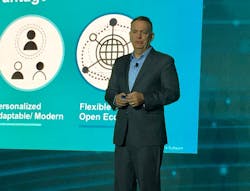Siemens PLM Name Change Reflects New Reach
Siemens PLM has long been known as the business unit housing the company’s organic and acquired technologies around computer aided design/manufacturing/engineering (CAD/CAM/CAE) simulation, as well as product lifecycle management (PLM). At Siemens' Media and Analyst Conference in New York this week, the company announced that Siemens PLM will now be known as Siemens Digital Industries Software.
Tony Hemmelgarn, CEO and president of the renamed business unit, said Siemens Digital Industries Software—which comprises PLM, manufacturing operations management (MOM) via Siemens OpCenter, and Internet of Things (IoT) app development—accounts for $4 billion in revenue. “This new name not only reflects our new position inside the core operating company of Siemens Digital Industries, but also how we’ve evolved from the industry leader in product lifecycle management to the company with the broadest portfolio of industrial software and services that is the foundation for digitalization strategies at companies around the world.”
Further explaining the new name and structure, Hemmelgarn said, “Most manufacturers struggle with complexity and look to limit it. But those who want to be the leader in their field need to be able to leverage complexity as a competitive advantage.”
Siemens said its Digital Industries Software business unit structure is aligned with an eye toward helping customers leverage the inherent complexities of their products to their benefit. A key aspect of this can be seen in the company’s first release under its new name—Xcelerator. This new product combines Siemens software, services, and development portfolio using a flexible architecture that can be adapted to customers’ needs, said Hemmelgarn.
The Xcelerator portfolio includes applications for PLM, electronic design automation (EDA), application lifecycle management (ALM), MOM, and the MindSphere IoT platform. The portfolio is designed to orchestrate the flow of information between all Xcelerator ecosystem participants and create a traceable digital thread, Siemens said. Xcelerator combines the full portfolio of Siemens’ software for design, engineering, and manufacturing with an expanded Mendix low-code, multi-experience application development platform to make it possible for anybody to easily build, integrate and extend existing data and systems.
Last year, Siemens announced its acquisition of Mendix to facilitate IIoT app development by end users. As part of Xcelerator, the Mendix platform now includes Siemens Mindsphere cloud and app services. Hemmelgarn explained that Mendix’s low-code and no-code development environments allow users to build, integrate, and extend their existing data and systems without the need for coding expertise.
Derek Roos, CEO of Mendix, said Mendix sits on top of the existing automation landscape and can connect to any system—PLM, ERP, CRM or asset—not just those from Siemens. "Siemens is committed to opening up its entire portfolio to be accessed through the Mendix platform," said Roos. "Mendix can be used to create apps that drill into assets, their subcomponents, and their data to access BOMs, CAD drawings, service history, and more.”
Beyond the incorporation of Mendix’s app development capabilities, other technologies incorporated in Xcelerator include:
- Capital software from Mentor Graphics (acquired by Siemens in 2017) integrated into Siemens NX software to allow engineers to create new products collaboratively; and
- Valor software (also from Mentor Graphics) integrated into Siemens Opcenter to expand the digital thread from design to manufacturing for continuous quality improvement.
About the Author
David Greenfield, editor in chief
Editor in Chief

Leaders relevant to this article:
